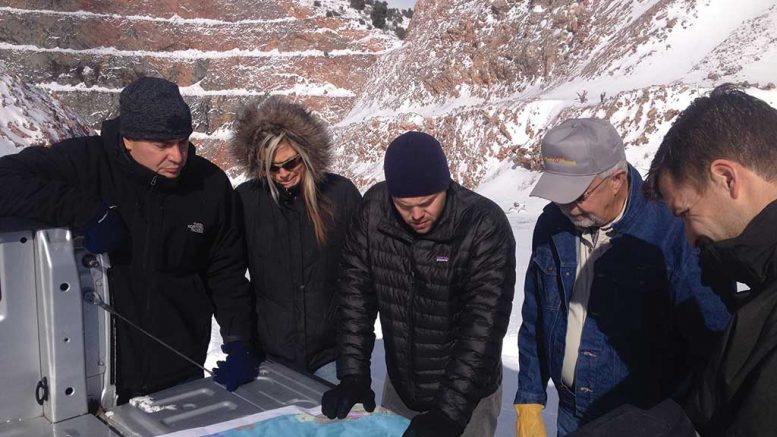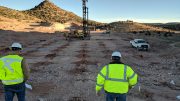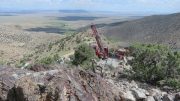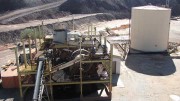Nevada has approved McEwen Mining’s (TSX: MUX; NYSE: MUX) final environmental impact statement for its Gold Bar project and the company says it will start building the gold mine immediately.
“Gold Bar is the first new gold mine in Nevada to gain permit approval in several years,” the company’s chairman and chief owner, Rob McEwen, said in a press release. “We advanced from draft environmental impact statement submittal to a record of decision in under eight months, a very brisk pace for the last leg of the permitting process.”
The company expects construction will take a year.
Gold Bar is in the Battle-Mountain-Eureka-Cortez gold trend of Eureka County in central Nevada. The project is 40 km from Waterton Global’s Ruby Hill mine to the southeast and 56 km from Barrick Gold’s (TSX: ABX; NYSE: ABX) Cortez mine to the northwest. (In 2016, the Cortez mine produced 1.1 million oz. gold at all-in sustaining costs [AISCs] of US$517 per ounce.)
An updated feasibility study on Gold Bar in late 2015 estimated initial capital costs of US$60.4 million.

High-grade gold in RC drill samples from McEwen Mining’s Gold Bar project in Nevada. Hydrothermal fluids decalcify carbonate host rocks in Carlin-style gold deposits, leaving behind gold and clay. Photo by Lesley Stokes.
The study envisioned a conventional open-pit mine with oxide gold heap-leach recovery that would produce 65,000 oz. gold a year over five years at average cash costs of US$728 per payable oz. gold and AISCs of US$995 per payable oz. gold.
Using a base-case gold price of US$1,150 per oz. the study estimated an after-tax net present value (NPV) at a 5% discount rate of US$30 million, a 20% after-tax internal rate of return (IRR) and US$22.5-million average annual cash flow. At US$1,300 per oz. gold, the post-tax NPV rises to US$67 million, the IRR to 36% and the average annual cash flow to US$31.5 million.
Over the life-of-mine, Gold Bar will recover 325,000 oz. gold (13 million tonnes of ore at a diluted grade of 1.1 grams gold per tonne).

The Gold Pick pit, one of three mining targets for production at McEwen Mining’s Gold Bar project in Nevada. Photo by Lesley Stokes.
Payback of the US$60.4 million in initial capex (which includes US$4.8 million, or 8%, for contingencies), is estimated to take three years at a gold price of US$1,150 per oz. and two years at a gold price of US$1,300 per ounce.
Additional capital expenses such as a heap-leach expansion and reclamation and closure obligations bring the total life-of-mine capital required to US$79.4 million, including another US$1.5 million (8%) for contingencies.
Both run-of-mine and screened and agglomerated oxide ore will be processed at a rate of 8,000 tons per day on a conventional heap leach, and using an adsorption-desorption recovery carbon plant, producing a doré product.
The company says there are opportunities to improve the economics at Gold Bar through continued exploration and capital cost reductions, among other measures.
In 2015, a drill program at Gold Bar consisting of 38 infill holes, which was intended to convert inferred resources to the measured and indicated category, returned several significant intercepts, including 4.65 grams gold per tonne over 41.1 metres and 2.2 grams gold over 52 metres. At the time, the company noted that exploration at Gold Bar had been limited since 2012, due to ongoing mine permitting activities and that, once the mine permit was received, it would test several priority targets to expand the resource and mine life.
Gold Bar has a measured and indicated resource of 611,000 oz. gold (22 million tons grading 0.95 gram gold) and an inferred resource of 111,000 oz. gold (4.6 million tons grading 0.82 gram gold).
In January 2016, McEwen Mining acquired 109 mining claims 5 km from Gold Bar that it calls Gold Bar South. The property hosts near-surface oxides and could become a satellite resource, and contribute to production at Gold Bar.
Receiving the final environmental permit was not only “great news” for the company but also for the state of Nevada, McEwen said in the Nov. 8 news release.
“Our mission to build Gold Bar has been ongoing since 2013, [and] during that time we have overcome many challenges involved in bringing a new mining project to fruition.”
The company’s shares were trading at $2.43 apiece in a 52-week range of $2.40 (September 2017) and $5.83 per share.
The company has 333 million shares outstanding for an $809-million market capitalization. Rob McEwen owns 24% of the company.
In addition to Gold Bar, McEwen Mining’s other major assets include the San Jose mine and the Los Azules project in Argentina; the El Gallo gold mine and El Gallo silver project in Mexico; and the Black Fox mine in Timmins, Ontario.






Be the first to comment on "Nevada green-lights McEwen Mining’s Gold Bar"